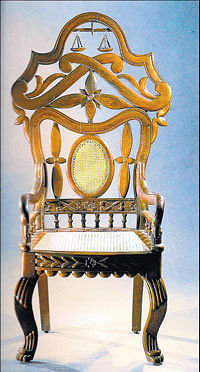This book is a treasure trove

How lofty it is to be a judge’s chair? The wooden chair judges used in the Bombay High Court in the late 19th century was not the same as the judges chair in the Allahabad High Court.
Though they share a family resemblance with chairs that were used since inception of the courts in India by the British in the 19th century, the ones in Allahabad was a standard-bearer as it were.
Many of those “kursis” may not be in use today in high courts or the Supreme Court. But there is a history to the crafts and imprint of traditions on paraphernalia that channelled the course of Indian judiciary.
The standard “wood and cane” made judge’s chair, so to say, had an inscription from the British Coat of Arms, engraved on the top of the backrest which read, “Honi Soit Mal Y Pense.”
But there were key differences too. The judge’s chair used in the Andhra Pradesh High Court of roughly the same period, has “ornate wood carvings and is designed as a throne”, reflecting the handicrafts that flourished under erstwhile Nizam of Hyderabad who had first established a High Court there.
Interestingly, the judge’s chair used in the Karnataka High Court in Bangalore, of 20th century make, had “originated from the Mysore (erstwhile princely state) court. This chair has the “scales of justice” as part of the design of the backrest.
And this story does not stop just with chairs. Other equally important insignia that evolved with the Indian court halls in pre and post-Independent times, unfold a packed symbolic phenomenology of their own.
From the “maces,” the “oars” used in “admiralty courts” that tried civil maritime disputes and piracy on the high seas, the “swords” bestowed on the “Sheriffs” to execute the orders and decrees of the courts, the ink pots made of Indian glass into which judges dipped their pens before writing their verdicts, to the “wigs” Indian judges used, the assortment is amazing.
Each little facet of this range of paraphernalia may need a culture historian to do full justice to their roles in aiding the social process of handing down procedural justice. For instance, the “silver maces” of the high courts at Bombay, Hyderabad, Bangalore and Calcutta, which were carried before the judges when they proceeded to the court room, and placing it on the table “is taken from the House of Commons in Britain, and symbolises the authority of the House, as also of the Speaker.”
The British practice of judges wearing wigs is no longer in vogue. But the wig of every judge was so meticulously preserved, first placed in a velvet cover to protect it from dust and then inside a cute carriage box which proudly displayed the judge’s name to indicate its unique possessor.
The quality water filter kept in the judge’s chambers-they were made by “Atkins Filter and Engineering Co Ltd, London”- is hard to miss as much as the “two-sided Marelli fans” of Italian make used in the courts.
All these and more have been exquisitely documented with a sprinkle of splendid period photographs in a little known publication, “50 Years of the Supreme Court of India and the Indian Legal System”, as part of the Apex Court’s Golden Jubilee celebrations in the year 2000, and published by the National Museum, New Delhi. “The Supreme Court is a confluence of many traditions and many ideas,” mused the then Chief Justice A S Anand.
The inclusion in this collection of facsimile reproductions of some rare and historically significant documents from the archives of the various courts and newspaper clippings makes this volume a rarer treasure. It is not only about the journey of the Indian judiciary through the ages, but also a thought-provoking collage of India’s past and later nationalist fervour.
“The Imperialist exploiters know that by crushing individuals, they cannot kill ideas. By crushing two insignificant entities, the nation cannot be crushed.” Such were the stirring words from the “Typed statement of Bhagat Singh” in 1929, in answer to charges leveled against him by the British.
Legal documents in Persian like “gift deeds” dated to the 1700s’ from the archives of the Andhra Pradesh High Court, a ‘Firman’ of Mogul Emperor Shahjahan dated 1615 with a seal of the King, another “Firman” of Aurangzeb dated 1659 (from Allahabad High Court archives) provide a glimpse into the Persian legacy that links the ancient Sanskrit “Dharma Shastras” like the “Yajnavalkya Smriti,” to modern Jurisprudence.
Pages from the trial of Mahatma
Gandhi in March 1922, when he and Shankarlal Banker were prosecuted for four articles written by Gandhi in “Young India” against the British is a living testimony to how the Mahatma carried his non-violent struggle into the portals of Justice.
Enhancing this catalogue’s richness are landmark events like M A Jinnah’s hand-written letter to the Bombay High Court in Sept 1896 requesting a certificate of his enrolment as an advocate. Weaved into this valuable tapestry are pictures like those of Justice Anna Chandy, the country’s first woman High Court Judge in the Kerala High Court.